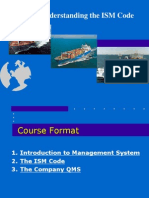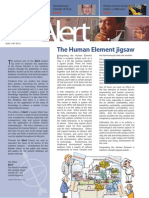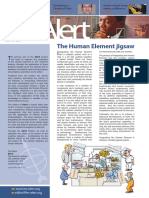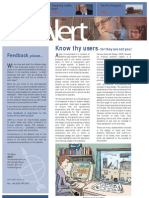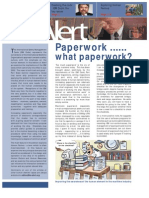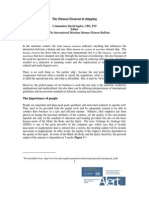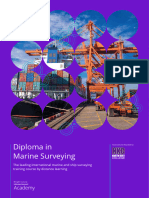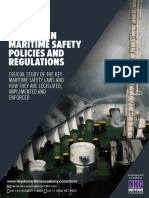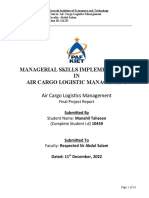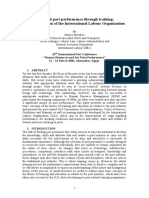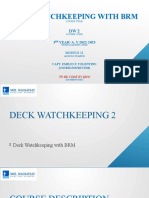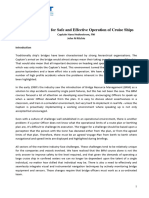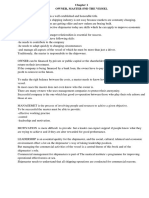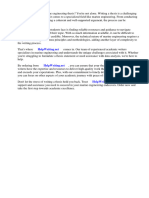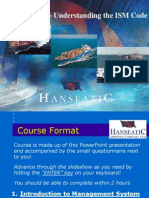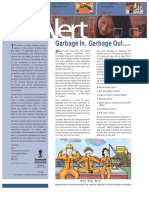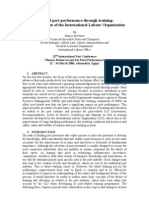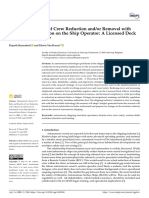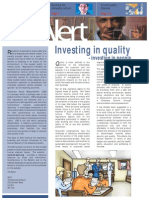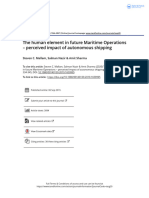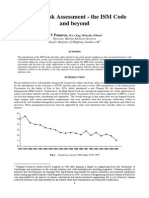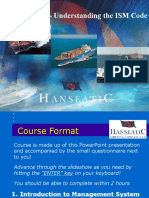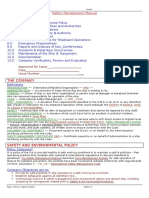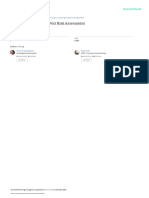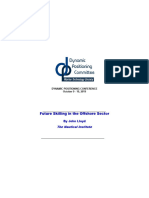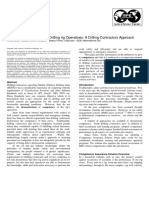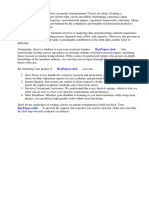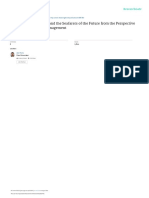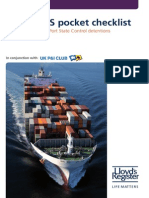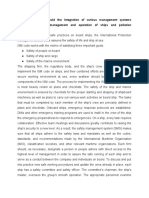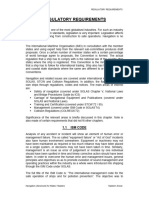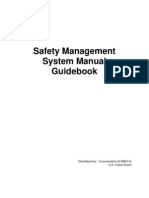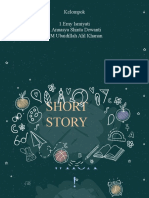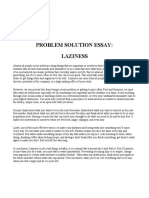Integrity, Professionalism Transparency - : A Good Surveyor The Hallmarks of
Integrity, Professionalism Transparency - : A Good Surveyor The Hallmarks of
Uploaded by
Tankut YıldızCopyright:
Available Formats
Integrity, Professionalism Transparency - : A Good Surveyor The Hallmarks of
Integrity, Professionalism Transparency - : A Good Surveyor The Hallmarks of
Uploaded by
Tankut YıldızOriginal Title
Copyright
Available Formats
Share this document
Did you find this document useful?
Is this content inappropriate?
Copyright:
Available Formats
Integrity, Professionalism Transparency - : A Good Surveyor The Hallmarks of
Integrity, Professionalism Transparency - : A Good Surveyor The Hallmarks of
Uploaded by
Tankut YıldızCopyright:
Available Formats
The International Maritime
Human Element
Bulletin
Issue No. 28 January 2012
ISSN 1747-5015
w: www.he-alert.org
e: editor@he-alert.org
A Nautical Institute project
sponsored by
Lloyds Register Educational Trust
R
esponsibilities come before
skills. Each of the Alert!
bulletins in this series is about
defining the responsibilities of a
particular stakeholder group with
respect to addressing the Human
Element. From these we intend
to develop descriptions of the
knowledge and skills necessary to
discharge those responsibilities.
But, we would not be user-
centred if we did this on our
own. Contributions from those
who have already benefited from
the right training and experience
will be essential to ensure that we
get it right. What we offer in the
centrespreads will serve as a first
draft, which we will ultimately
develop through the Alert!
website, with a view to providing
a comprehensive human element
skills framework for all the
various stakeholders by the end
of this series of bulletins.
Feedback, therefore, is essential
and very welcome.
Through the Alert! bulletins and
the website, we seek to represent
the views of all sectors of the
maritime industry on human
element issues. Contributions for
the Bulletin, letters to the editor
and articles and papers for the
website database are always
welcome.
The Editor
Alert!
The Nautical Institute
202 Lambeth Road
London SE1 7LQ
United Kingdom
editor@he-alert.org
I
n many respects, the surveyor/
inspector is the epitome of what the
human element is all about, because
he/she is one of the few whose role
it is to interact directly with other
humans, primarily the seafarers. The
surveyor therefore needs to possess
many human element attributes plus
the knowledge and skills to do the job.
That is not to say that every surveyor
and inspector needs to be a human
element expert, but they must at least
have an understanding of its relevance
in the design, build and operation of a
ship and its systems to what extent
depends on the specific role of an
individual surveyor or inspector.
The required knowledge, skills and
attributes of a surveyor/inspector are
many and varied. Not only do they
need to have the necessary professional
qualifications but also they must be
able to relate to those with whom they
will come into contact, both ashore
and afloat, in the course of their work.
To this end, they must have a good
knowledge of the ways of the sea -
ideally, they should have held a senior
position at sea so that they can use
their technical skills to exercise
professional judgement. They must
be current not only in their knowledge
of the regulations but also in
understanding the latest technology
and how it is applied onboard ship.
They must also be able demonstrate
good leadership and the ability to
communicate effectively to those
whose first language may not be the
same as theirs. And, they must be
capable of producing concise written
reports, with clarity of thought, and
which are understandable even to
those whose first language may be
different to that in which the report
is written.
The IMOs Code of Good Practice for
Port State Control Officers (PCSOs)
encompasses three fundamental
principles against which all actions
of PSCOs are judged: integrity,
professionalism and transparency.
These are the principles that should
be adopted by any person who is
engaged in the business of surveying
or inspecting ships and their systems
which of course, includes the people
who operate them.
These principles are the hallmarks
of a good surveyor/inspector and
should bring with them the need to
understand how humans interact with
other humans, machines and systems.
Integrity, professionalism and
a good surveyor
transparency - the hallmarks of
2
The need for human element competence
T
his article con-
siders how the
human element rel-
ates to my role running the Assessment
and Inspection department in BP
Shipping. The department is responsible
for approximately 3,500 bespoke pieces
of assessment a year, largely SIRE ship
inspections but also encompassing
technical manager, marine terminal and
structural assessments.
The oft mentioned perception, particularly
when it comes to ship inspections, is that
there need to be winners and losers, that
inspectors attend to find fault and that
they are programmed to find as many
issues as possible. My own perception
of this is entirely different - inspectors
attend vessels on behalf of a principal,
and - certainly in the case of BP - they are
onboard to undertake a quantified risk
assessment of the vessel and her operation
to determine if the level of risk to the
business is acceptable for the potential
carriage of one of our cargoes. Differing
perceptions are a classic symptom of
the human element. I believe that in
this instance our required outcomes are
similar and with some slight changes in
behaviour we could be better aligned and
able to deliver what we are all looking for
- safer vessels.
The benefit a ship inspector brings to
the equation is an independent,
experienced set of eyes to help manage
our risk, and yours. You possibly see one
thing due to familiarity, we possibly
see things differently, bringing a fresh,
experienced approach.
To quote from UK Maritime and Coastguard
Agency (MCA) publication The Human
Element - a guide to human behaviour in the
shipping industry: Humans are not simply
an element like the weather. They are at
the very centre of the shipping enterprise.
They are the secret of its successes and
the victims of its failures. And: Our ability
to share situations, goals and meaning
depends on two other key human
properties: empathy and communication.
During an inspection, many of the
conversations have the potential to
become difficult. Ensuring all parties
understand the outcome of these
O
ne way for the human element to
make an impact on a large scale is
through the inclusion of ergonomic design
requirements in Classification Rules and
Regulations. Class provides a means,
with corresponding verification, to make
far-reaching ergonomic improvements,
benefiting a large number of seafarers.
A consideration of ergonomics in ship
design will help to enhance operational
safety, reduce the risk of error and improve
efficiencies and situational awareness.
A key part of the Lloyds Register strategy
for the human element is to improve the
way it is addressed in its core Rules. This is a
challenging activity and one which has no
quick win solution. There are a wide variety
of hurdles that need to be overcome during
the rule development process. However,
progress is being made, and this year sees
the first major ergonomics input to the
Rules, addressing ergonomics at control
stations and in the presentation of alarms.
However, having well written, verifiable
ergonomic Rule requirements addresses
only one part of the Lloyds Register
strategy. The verification of any ergonomic
requirements in the Rules will be
undertaken by surveyors. Therefore, any
attempt to address the human element in
the Rules requires that the competence of
surveyors is increased at the same time as
the Rules are revised.
Unfortunately, knowledge and awareness
of the human element is often poor
or indeed absent among surveyors.
Surveyors are trained to make decisions
about engineering not human behaviour.
They generally receive no more than basic
training in matters such as Occupational
Safety and Health (OSH) or work system
design. Hence, raising awareness of the
subject is an essential first step if the
benefits of improved design are to be
realised. The need to have a human
element competency framework for
surveyors is now recognised as being as
important as having a Rules development
strategy in this area.
Following an analysis of the knowledge,
skills and attitudes required for a baseline
human element competency, a suitable
training delivery programme has been
proposed. In the first instance, a human
element e-learning course with online
assessment will be developed to raise
awareness. This course will be fairly basic
in scope, as it needs to lay the foundations
of education in this subject. The intention
is for the course to be rolled out in early
2012 and for it to be completed by all
marine surveyors. Successful completion
of the training and its assessment will
become the means to assess surveyor
competency in the human element.
The success of the training course will
be measured by our training feedback
process and by the number of enquiries
received from surveyors. We do not
expect surveyors to make expertise-based
human element decisions, but we do
hope that they will be able to recognise
human element issues and will seek
assistance from a human element specialist
when required.
As the Rules develop in the different
engineering areas, specific training will
be developed. These training courses will
then become part of the competency
schemes within the specialised domains.
The full paper on which this article is based can be
downloaded from:
www. he- al er t . org/ document s/ publ i shed/
he01035.pdf
among Classification Society Surveyors
conversations is not about winning and
losing, but about creating an opportunity
for improvement. Instilling behaviours
that are respectful of others positions, and
empowering all parties to have a voice
and be willing to use it, are important. In-
spectors should be respectful of the officers
and crew and the fact they are temporarily
in their living and working environment.
On the other hand, ships staff also need to
be respectful of the inspector he/she is a
well-qualified and experienced individual
representing a customer.
In the event that respect and basic
communications are evident and in place,
I believe the inspection process has the
ability to deliver mutual benefit.
The Human Element publication has
relevance for every aspect of what we do
in our industry. I should have read it when
changing roles recently; it helps inform
your perception of everything you do.
The Human Element a guide to human
behaviour in the shipping industry is
downloadable from:
www.dft.gov.uk/mca/the_human_element_a_
guide_to_human_behaviour_in_the_shipping_
industry
Winners and losers
Captain Andy Glass, Manager, Assessment & Inspection, BP Shipping Ltd
an oft mentioned perception
Olivia Walker, Curriculum Leader, Senior Specialist Human Element, Lloyds Register
3
2012 marks JCP Marines 20th anniversary.
During that time we have developed
our own criteria for recruiting marine
surveyors. Whilst we survey a diverse
variety of ship types generally for
underwriters, charterers and law firms
we are well known for our tanker
expertise and place a strong premium
on our surveyors possessing good tanker
qualifications and experience. Other
companies will have their own specific and
individual needs. In this short article, I will
take you briefly through our recruitment
criteria for surveyors.
At its heart we need technically qualified
personnel. Borrowing from the Ship
Inspection Report (SIRE) and Chemical
Distribution Institute (CDI) programmes,
this translates into the applicant holding
a certificate of Competency (Deck Officer
or Marine Engineer) Class 1 with at least
an Oil Dangerous Cargo Endorsement;
having a total of 60 months sea time
served on tankers; of which at least 24
months has been in the capacity of senior
officer i.e. Master, Chief Engineer, Chief
Officer or Second Engineer Officer.
Captain Julian Brown, CEO, JCP Marine Pte Ltd, Singapore
Our preference is that candidates already
possess lead auditor qualifications, but will
consider those who have completed ISM or
ISO internal auditor training at a recognised
training establishment. If necessary we will
complement the candidates basic ISM and
ISO certification with externally provided
ISO 14000 and ISO 18000 training.
Beyond the those basic technical
qualifications, we need surveyors who are
knowledgeable with respect to industry
standards and international rules and
regulations appropriate to the vessels
being inspected. In-house Computer
Based Training (CBT) software allows us to
independently verify technical skill levels.
Less easily defined perhaps, but the softer
skills can be as equally important as technical
ability. The ability to communicate clearly
and effectively with ships staff is essential.
Generally that means possessing a good
standard of spoken English, although for
some regional offices where it is primarily
domestic trade that is surveyed, that can
be a secondary consideration. Clarity of
thought; a logical approach; and the ability
to produce concise written reports, are all
essential client requirements.
Human element skills and knowledge
Safety awareness is paramount and a
surveyor needs to be constantly aware
of the risks and hazards that surround
him. As we are frequently reminded, ships
can be dangerous places: enclosed space
entry incidents remain a depressingly
common feature of our industry. Wearing
the appropriate safety apparel, carrying
a suitable gas meter and setting a good
example regarding PPE and safety when
on board ship are in my mind important
attributes of a surveyor.
The range of survey requirements means
that not all skills are required by all
surveyors. The temperament and technical
abilities needed to assess the condition of
tank coatings do not neatly overlap with
the ability to analyze the documentation
relating to a fuel oil cargo contamination
nor again with assessing navigation
practices and machinery incidents.
Independence, integrity and an inquisitive
mind are all essential traits, which in my
experience most mariners who come
ashore already possess. There are many
more I could go on and list. But thats for a
future article perhaps.
Rear Admiral J A Watson, USCG Director, Prevention Policy
C
urrently, US vessels engaged on
foreign voyages and subject to SOLAS
must comply with the International Safety
Management (ISM) Code. ISM auditing
has been delegated to recognized class
societies. Class society ISM auditors must
be certified to the International Register
of Certified Auditor (IRCA) competency
standards.
The Coast Guard offers a Streamlined
Inspection Program (SIP) as an alternative
to traditional Coast Guard inspections.
Much like SMSs, company personnel
conduct frequent, periodic examinations
of the various vessel systems, document
their findings, and take the necessary
corrective actions. A third party auditor is
not required. Under this program, the Coast
Guard still conducts required inspections
of participating vessels; however, the
manner of conducting the inspections is
more to verify that company personnel
have completed self examinations and
corrected discrepancies in accordance
with an approved streamline inspection
program.
The Coast Guard has published proposed
regulations governing the inspection,
standards, and safety management
systems on towing vessels to promote
safer work practices and reduce casualties
by requiring that towing vessels adhere
to prescribed safety standards and safety
management systems.
Through this rulemaking, the Coast Guard
intends to broaden the available pool
of auditors, beyond those authorized to
conduct audits for ISM (now, only our
authorized classification societies) to
include organizations that meet prescribed
standards. The proposed rule for towing
vessel safety auditors requires that
states auditors must meet the following
qualifications:
High school diploma or equivalent
Four years of experience working on
towing vessels or other relevant marine
experience such as Coast Guard marine
inspector, military personnel with
relevant maritime experience, or marine
surveyor
Successful completion of an International
Organization for Standardization (ISO)
9001-2000 lead auditor/assessor course
or Coast Guard recognized equivalent
Successful completion of a required
training course for the auditing of a
Towing Safety Management System
Audit experience, as demonstrated by
documented experience in auditing the
ISM Code or the American Waterways
Operators Responsible Carrier Program,
consisting of at least two management
audits and six vessel audits within the
past 5 years; or successful completion
of a required auditor apprenticeship,
consisting of at least one management
audit and three vessel audits under the
direction of a lead auditor.
In summary, the Coast Guard has shown
commitment to safety management
system audits and expects those who
conduct audits, whether for ISM or other
forms of SMS, to have both formal training
and marine industry experience. Further,
the Coast Guard has recognized the
difference between an inspectors skill
set and an auditors skill set in each of
its implementing policy decisions and
generally expects auditors to come from
the private sector.
Subscribe to CG Maritime Flag Forum at http://cgls.
uscg.mil/mailman/listinfo/cgmaritimeff
The US Coast Guard application of
required of P&I surveyors and inspectors
Safety Management Systems and Auditor skills
Surveyors & Inspectors Knowledge, Skills & Attributes
,OPXMFEHF
5FDIOJDBM
Pellablllty and
avallablllty, system
performance,
lnstrumentatlon,
monltorlng,
automatlon, man-
machlne lnterface,
work place
condltlons
)BCJUBCJMJUZ
MLC 2006
&YQFSJFODF
'Knowledge of the sea',
seagolng experlence at
senlor level
$POWFOUJPOTSFTPMVUJPOT
SVMFTBOESFHVMBUJPOT
|MO, |LO, wHO Conventlons &
Pesolutlons, Plag State regulatlons,
Class rules
*OEVTUSZ
TUBOEBSET
|SO, |LC, 8est Practlce
Guldes
$POUFYUPGVTF
Goals, users,
tasks, physlcal,
soclal, managerlal
envlronments
4BGFUZBXBSFOFTT
Onboard occupatlonal
health and safety
hazards
$POUJOVPVT
QSPGFTTJPOBM
EFWFMPQNFOU
Updatlng of knowledge
$VMUVSBM%JFSFODFT
Pellglon, natlonal
tradltlon, dress, language
)VNBOTZTUFN
JOUFSGBDF
Human-human,
human-machlne,
human-computer,
usablllty
"UUSJCVUFT
)VNBOFMFNFOU
Pelevance ln deslgn, bulld and
operatlons, benets of addresslng the
human element, regulatory expectatlons,
Context of Use analysls for deslgn
evaluatlon of human
element lssues,
"UUJUVEF
Self-awareness, self-
motlvatlon, mental ablllty,
lntelllgence, personallty,
character, sensltlvlty
1SPGFTTJPOBMJTN
Professlonal standards
*OUFHSJUZ
Moral soundness, honesty,
freedom from corruptlng
lnnuences, unpre[udlced
.PUJWBUJPO
Communlcatlon, dlrectlon,
teamwork, empowerment,
character bulldlng, leadershlp,
lnteroperablllty, adaptablllty
4FMGBDUVBMJTBUJPO
Prlde, sense of purpose, ldentlty,
aesthetlcs, convlctlon, trust,
expectatlon, reallsatlon, belonglng,
loyalty, esteem, fellowshlp,
securlty
4FMGBDUVBMJTBUJPO
Prlde, sense of purpose,
ldentlty, aesthetlcs,
convlctlon, trust,
expectatlon, reallsatlon,
belonglng, loyalty, esteem,
fellowshlp, securlty
5SBOTQBSFODZ
Openness,
accountablllty
5FNQFSBNFOU
Pespectful, pollte,
rm, courteous,
calm, patlent
*NQBSUJBMJUZ
|ndependent, unblased,
conslstent, lnformed
declslon maklng
$PNNVOJDBUJPO
Clear and enectlve
1IZTJDBM4UBUF
Personal health & hyglene,
tness, balanced
dlet
1IZTJDBM$BQBCJMJUZ
Strength, stamlna, stress, fatlgue, paln/
dlscomfort, hunger, thlrst, temperature
extremes, vlbratlon, movement
constrlctlon, lack of physlcal exerclse,
dlsruptlon of clrcadlan rhythm
1TZDIPMPHJDBM$BQBCJMJUZ
Perceptlon, lnterpretatlon, declslon-maklng,
lnformatlon load, narrowness of task,
frequency & repetltlveness, task crltlcallty,
long/short-term memory, calculatlon
requlrements, feedback (knowledge of
results, team structure &
communlcatlon
4LJMMT
)VNBOFMFNFOU
Ablllty to recognlse
human element
lssues
$PNQFUFODF
Lducatlon, tralnlng,
competencles, knowledge,
understandlng, aptltude,
Sklll, proclency
&YQFSJFODF
Currency, leadershlp,
professlonal [udgement,
technlcal skllls
4BGFUZBXBSFOFTT
Settlng a good
example
$PNNVOJDBUJPO
Clarlty of thought, ablllty
to produce conclse wrltten
reports, body language,
lntervlew technlques,
language dlnerences
*OUFSWJFXUFDIOJRVFT
Asklng the rlght questlons,
open, closed and leadlng
questlons, how to keep
people on-slde, recognlze
and deal wlth defenslve/
aggresslve responses,
keeplng focussed, gettlng
the correct data/co-
operatlon
$POUJOVPVT
QSPGFTTJPOBM
EFWFMPQNFOU
Updatlng of skllls
4
Surveyors & Inspectors Knowledge, Skills & Attributes
,OPXMFEHF
5FDIOJDBM
Pellablllty and
avallablllty, system
performance,
lnstrumentatlon,
monltorlng,
automatlon, man-
machlne lnterface,
work place
condltlons
)BCJUBCJMJUZ
MLC 2006
&YQFSJFODF
'Knowledge of the sea',
seagolng experlence at
senlor level
$POWFOUJPOTSFTPMVUJPOT
SVMFTBOESFHVMBUJPOT
|MO, |LO, wHO Conventlons &
Pesolutlons, Plag State regulatlons,
Class rules
*OEVTUSZ
TUBOEBSET
|SO, |LC, 8est Practlce
Guldes
$POUFYUPGVTF
Goals, users,
tasks, physlcal,
soclal, managerlal
envlronments
4BGFUZBXBSFOFTT
Onboard occupatlonal
health and safety
hazards
$POUJOVPVT
QSPGFTTJPOBM
EFWFMPQNFOU
Updatlng of knowledge
$VMUVSBM%JFSFODFT
Pellglon, natlonal
tradltlon, dress, language
)VNBOTZTUFN
JOUFSGBDF
Human-human,
human-machlne,
human-computer,
usablllty
"UUSJCVUFT
)VNBOFMFNFOU
Pelevance ln deslgn, bulld and
operatlons, benets of addresslng the
human element, regulatory expectatlons,
Context of Use analysls for deslgn
evaluatlon of human
element lssues,
"UUJUVEF
Self-awareness, self-
motlvatlon, mental ablllty,
lntelllgence, personallty,
character, sensltlvlty
1SPGFTTJPOBMJTN
Professlonal standards
*OUFHSJUZ
Moral soundness, honesty,
freedom from corruptlng
lnnuences, unpre[udlced
.PUJWBUJPO
Communlcatlon, dlrectlon,
teamwork, empowerment,
character bulldlng, leadershlp,
lnteroperablllty, adaptablllty
4FMGBDUVBMJTBUJPO
Prlde, sense of purpose, ldentlty,
aesthetlcs, convlctlon, trust,
expectatlon, reallsatlon, belonglng,
loyalty, esteem, fellowshlp,
securlty
4FMGBDUVBMJTBUJPO
Prlde, sense of purpose,
ldentlty, aesthetlcs,
convlctlon, trust,
expectatlon, reallsatlon,
belonglng, loyalty, esteem,
fellowshlp, securlty
5SBOTQBSFODZ
Openness,
accountablllty
5FNQFSBNFOU
Pespectful, pollte,
rm, courteous,
calm, patlent
*NQBSUJBMJUZ
|ndependent, unblased,
conslstent, lnformed
declslon maklng
$PNNVOJDBUJPO
Clear and enectlve
1IZTJDBM4UBUF
Personal health & hyglene,
tness, balanced
dlet
1IZTJDBM$BQBCJMJUZ
Strength, stamlna, stress, fatlgue, paln/
dlscomfort, hunger, thlrst, temperature
extremes, vlbratlon, movement
constrlctlon, lack of physlcal exerclse,
dlsruptlon of clrcadlan rhythm
1TZDIPMPHJDBM$BQBCJMJUZ
Perceptlon, lnterpretatlon, declslon-maklng,
lnformatlon load, narrowness of task,
frequency & repetltlveness, task crltlcallty,
long/short-term memory, calculatlon
requlrements, feedback (knowledge of
results, team structure &
communlcatlon
4LJMMT
)VNBOFMFNFOU
Ablllty to recognlse
human element
lssues
$PNQFUFODF
Lducatlon, tralnlng,
competencles, knowledge,
understandlng, aptltude,
Sklll, proclency
&YQFSJFODF
Currency, leadershlp,
professlonal [udgement,
technlcal skllls
4BGFUZBXBSFOFTT
Settlng a good
example
$PNNVOJDBUJPO
Clarlty of thought, ablllty
to produce conclse wrltten
reports, body language,
lntervlew technlques,
language dlnerences
*OUFSWJFXUFDIOJRVFT
Asklng the rlght questlons,
open, closed and leadlng
questlons, how to keep
people on-slde, recognlze
and deal wlth defenslve/
aggresslve responses,
keeplng focussed, gettlng
the correct data/co-
operatlon
$POUJOVPVT
QSPGFTTJPOBM
EFWFMPQNFOU
Updatlng of skllls
5
Photo: Maritime and Coastguard Agency
C
lassification society surveyors attend
new vessels under construction,
vessels damaged or under repair or
annually for routine inspection while the
vessels are in service. The surveyors job
is to ensure that vessels surveyed comply
with the own rules of the class society and
the statutory requirements of the Flag
states they are authorised to represent.
Given the multitude of new ship types and
MOUs afloat today and the trend towards
the concentration of dry dock surveys in
a fewer and fewer locations worldwide
the challenge of training surveyors who
are able to support the industry with
practical solutions which comply with all
the required regulations is increasing.
Many surveyors join classification societies
with degrees in naval architecture as I did.
In the development of my training plan I
asked for the opportunity to go to sea and
within a few months of joining DNV I was
signed onto a 23 year old open hatch bulk
carrier with twin gantry cranes. Half of my
time was spent in the engine room and the
other half on the deck side. Participating
in auxiliary engine overhauls, changing
a cylinder liner at sea and joining bridge
watch keeping and cargo operations
were highlights.
Seek the opportunity to sail on a merchant
vessel to gain a better understanding of
how ships are operated as this will improve
your knowledge and communication with
the crew and officers on board. This in
turn will make you a much more effective
surveyor, designer or auditor as often the
best way of finding out the strengths and
weaknesses of the team on board and
the true condition of the ship is to ask the
right questions.
Opportunities to participate in dry
dockings and voyage surveys have reduced
in some parts of the world. Although no
direct substitute for practical experience,
surveyor competence development can
be supplemented and enhanced through
virtual reality training which is increasingly
used by the military today.
In 2009 DNV developed a ship survey
simulator called SuSi. Initially this was
available only at our training school in
Gdynia, Poland, where it was developed
but it has been used in classrooms around
the world and finally has been installed
on each surveyors laptop. Thousands of
survey findings and damage cases have
been entered based on DNVs knowledge
base to test the surveyors knowledge of
statutory requirements, terminology and
reporting. For instance load line convention
specific items can be highlighted on the
ship to aid clarity.
M
any of the skills
will be the
same or similar to
those needed today. There will however
be an increased requirement to show that
one has acquired training and gained the
skills in a planned and focused manner and
that continuous professional development
(CPD) had been and is an ongoing feature
of all surveyors lives.
The Human Element requirements for
commercial surveyors have never been
considered at any stage other than at a very
basic level during interview procedures.
Given that the main task for surveyors
is to determine the cause of damage,
accidents and incidents it will be
necessary to consider some of the skills
that might be necessary in other walks
of life where human element skills are
being recognized.
The most basic I have come across is
body language training that I learnt
(amongst other techniques) when
training as a mediator (I look at everyone
differently now!).
There are important Interview training
techniques to understand in respect
of open, closed and leading questions.
Other aspects of mediator and arbitration
training cover report writing, necessary
procedures and case studies. Surveyors,
consultants and expert witnesses
could all benefit enormously from such
training which would allow one to
recognize how to keep people on-side,
how to recognize and deal with the
defensive/aggressive responses, and how
to keep your own focus.
There will also be specific on the
job situations in the field such as on a
damaged ship, in a hold with damaged
cargo or just in the ships office which
beg the questions:
Are you getting the data/co-operation
you need?
Are you working with or against your
opposite number?
Have you got the right attitude?
What are your negotiation strategies?
We have many of the techniques to be
invaluable in forming better interviewing
techniques, better guidance to surveyors
for interviewing potential witnesses
and to improve techniques for general
information gathering.
All of the above will require increased
training, CPD and attention to changing
legislation. The IIMS is the only body in
the world dedicated to the training and
education of marine surveyors and marine
consultants; and, new and tailored short
courses are coming on line all the time.
www.iims.org.uk
Captain Chris Spencer, Chairman, Commercial and Technical Group, International Institute of Marine Surveying
Surveying and inspection of ships
The human element requirements for the future
6
Human factors in surveyor training
- meeting the challenge
Just as in real life, the surveyors have a
camera, torch and spray to use in the
simulation. Part names, certificates and
surveyor checklists are displayable on a
virtual PDA as they move around the ship. In
tank inspections torch light is simulated to
demonstrate the difference good lighting
makes to observations. Close-up surveys
using cherry-pickers is also simulated. As
trainees develop the skills they need to
report findings correctly, they must also
deal with the safety hazards that would be
experienced on board a real ship.
Conditions such as corrosion and coating
failure can be accelerated or retarded
and resulting damages included that vary
depending on the structure involved and
the ships history. All of this is presented
in a realistic 3D environment which allows
views from any angle including the bottom
in dry dock which accelerates experience
in reporting structural defects accurately.
Even very experienced surveyors have
been surprised by what they learned in
the simulator.
Human factors and experience cant be
replaced by technology; however we
should embrace it as part of the solution
to enhance the competence of surveyors
going forward.
For more information on SuSi, go to:
www.dnv.com and search survey simulator
Martin Crawford-Brunt, DNV Classification Manager, UK & Ireland
A
rticle IV of MLC, 2006 lays down
the seafarers employment and
social rights. It is the responsibility of
each Administration to ensure that the
seafarers rights provided under titles 1, 2, 3
and 4 of MLC, 2006 are fully implemented
in accordance with the requirements of
the Convention.
Many of the requirements of the
Convention are implemented through
national rules and regulations and
collective bargaining agreements and
can be inspected through a review of
the records on board, such as the records
of hours of work or rest and payment of
wages. However some requirements such
as those like fatigue, stress, health and the
over-all well-being of seafarers, which are
related to the human element, may not
be readily inspected through records and
paper-work.
That is why inspectors carrying out
maritime Labour inspections should not
only be aware of the visible evidence
of compliance with the seafarers social
and employment rights, but also of
the hidden factors related to the well-
being of seafarers, such as their culture,
attitude and beliefs. Inspectors should be
able to see the broader picture during a
Maritime Labour inspection and be able
to effectively communicate with seafarers
including listening to complaints and
where possible, resolving complaints on
board.
Inspectors are not psychologists, doctors,
social workers or lawyers who can solve
all problems related to seafarers well-
being, but being the representative of the
Administration, they can, where required
certainly listen to seafarers and transmit
the information to the Administration.
Inspectors are and must be persons of
authority, integrity, discernment and
independence. An inspector must be
able to recognize deficiencies and seek
shipowners to propose remedies to
deficiencies.
The standard of safety on a ship is dependent
not only on the health of the ship but more
on the health of the seafarers in charge of
the operation of the ship (M Fuazadeen
of IMO)
Mariners who have seen ships become
harder worked, meaner places, with
insufficient attention given to anything
other than revenue generation might be a
little skeptical at any enthusiasm for softer
values (Michael Grey)
Investment in crew will provide returns
far in excess of the cost involved, but to
achieve this, you have to design ships that
fit snugly around their human operators
not just fitting people in where they
wont interfere with the cargo or propulsion
machinery at the very end of the design
process (Michael Grey)
The competency and professionalism
of seafarers are seriously undermined
by personal concerns and emotional
debilitation. Lack of well-being impacts
upon performance and introduces
Maritime Labour Convention Inspectors
The Alert! vodcasts aim to raise the
awareness of maritime human element
issues amongst the estimated 500,000
students engaged in all disciplines of
maritime study. Sponsored by The Lloyds
Register Educational Trust, and produced
by The Nautical Institute, in conjunction
with Videotel, these vodcasts exploit
the power of high quality multimedia
presentation specifically designed to
be viewed and shared by international
maritime students.
The 3-5 minute videos are designed to
engage the younger generation of
students studying disciplines such as
navigation, engineering, naval architecture,
surveying, law, finance, insurance and
administration - many of whom may have
never experienced the environment of a
ship at sea.
The first 7 vodcasts can be downloaded
from: www.he-alert.org/user/vodcasts.asp,
a further 14 will be available for download
during the course of the next few months.
7
Addressing the Human Element
Cedric DSouza, Liberian International Ship and Corporate Registry The Reverend Canon Ken Peters, Mission to Seafarers
unacceptable risks that detract from the
safe operation of the vessel.
Even on the best run ships, modern
shipping operations contribute to
isolation and stress for seafarers. The ILO
Commission was told of social and mental
problems arising from long absences from
home and the lack of means to contact
families for extended periods and social
isolation on board arising from the use
of mixed crews with widely different
cultural, linguistic and other requirements.
These problems are compounded by the
remoteness of many modern ports and
terminals from sources of social inter-
action. Shorter stays in port, with minimal
time for rest and recreation add to fatigue.
MLC, 2006 requires that seafarers working
on board a ship have access to shore-
based facilities and services to secure their
health and well-being.
In addition to inspecting and certifying
ships for compliance with the requirements
of MLC, 2006, Administrations should also
ensure that their inspectors are able to
address welfare concerns of seafarers such
as those related to: paying to obtain jobs;
non-payment of wages; abandonment;
denial of medical care; restrictions and/or
denial of shore leave; fatigue and stress;
blacklisting; and denial of repatriation. All
of these have a significant impact on the
well-being of seafarers, have implications
for their health and safety and the safe
navigation of ships.
Liberia has been the front runner in
preparing its Maritime Labour Inspectors
with specialized training provided by the
Missions to Seafarers, in addressing the
human element during Maritime Labour
inspections, having trained over 100
inspectors to date.
Alert! Vodcasts
Lack of well-being impacts
upon performance and
introduces unacceptable risks
that detract from the safe
operation of the vessel
8
Accident
Investigation
Reports
T
his joint report from the UK MAIB and
the Bahamas Maritime Administration
features a fire that broke out on the main
vehicle deck of a 14,000 grt ro-ro passenger
vessel. It highlights a number of issues
relating to the safety of the ship, its crew,
passengers, stevedores and fire and rescue
service personnel.
Whilst on passage, a fire was detected on
the main vehicle deck. The officer of the
watch and duty engineer initially thought
the alarm was due to a fault with the fire
detection system, and the vehicle deck
water drenching system was not started
until 20 minutes later.
The fire developed in an unaccompanied
curtain-sided refrigerated trailer that
was carrying a load of potatoes. The
trailer roof shielded the flames from the
drenchers and the fire continued to burn.
The trailers were tightly stowed; crew had
great difficulty gaining access to the fire
and were unable to extinguish it.
Unprotected cables and pipework run-
ning above the fire were soon damaged
in the high temperatures that were
generated by the burning curtain-side
and cargo packaging materials.
The vessel lost power to forward mooring
deck winches and bow thrusters, and
control of the rudders was disrupted.
Loose cargo partially blocked the deck
drains and drencher water caused the
ship to list. Drenching was stopped while
water drained to prevent further risk to
the vessels stability, but each time it was
stopped, the fire grew in intensity.
With tugs standing by, the ship entered
harbour and berthed alongside. The
control circuits for the ro-ro hydraulics
had been burnt out, but the engineers
managed to bypass the system and were
able to open the stern door. Few foot
passengers were carried on the route and
the ship never used a gangway. Although
the port was able to provide a gangway,
it was difficult for personnel to move
through the tightly stowed vehicles on
the upper vehicle deck to get from the
gangway into the accommodation. It was
decided that it was safer to leave the
62 passengers on board rather than risk
evacuating them by the gangway, lifeboat
or marine evacuation system.
The local fire and rescue service (FRS)
attempted to gain access to the seat of the
fire, but struggled to get past the vehicles
and make their way through the cargo
debris. Firefighters, crew and stevedores
worked together to contain the fire,
unlash and remove undamaged trailers.
Once a route through the main vehicle
deck had been cleared the passengers
were escorted off, nearly 20 hours after
the fire had first been detected.
Subsequent investigation found that the
fire was due to one of the ships reefer
cables being assembled incorrectly.
The purpose of this summary is to highlight
certain human element issues arising from
this incident; there are many other issues
highlighted in this very comprehensive accid-
ent report. Those who are involved in the
design, regulation, management and operation
of ro-ro passenger vessels are strongly advised
to read the whole report which identifies all
the safety issues raised by the case, and can be
downloaded from:
www. ma i b . g o v . u k / c ms _ r e s o u r c e s /
CommodoreClipper_Compiled.pdf
&
Reports
Studies
This bulletin is distributed and promoted with the kind support of:
Global Maritime Education & Training Association (GlobalMET); International Federation of Shipmasters' Associations
(IFSMA); International Institute of Marine Surveying (IIMS); Institute of Marine Engineering, Science and Technology
(IMarEST); International Maritime Pilots' Association (IMPA); NewsLink; Royal Institute of Navigation (RIN); Royal
Institution of Naval Architects (RINA)
Fire on the main vehicle deck of a ro-ro passenger vessel
The International Maritime
Human Element Bulletin
Editor: David Squire, FNI
Published by the Nautical Institute, the
worlds leading international professional
body for qualified mariners
www.nautinst.org
Membership info: sec@nautinst.org
The opinions expressed herein are those of the editor
or contributors and do not necessarily represent the
views of The Nautical Institute or Lloyds Register.
The Nautical Institute and Lloyd's Register, their
affliates and subsidiaries and their respective offcers,
employees or agents are, individually and collectively,
referred to as 'The Nautical Institute and Lloyd's
Register'. The Nautical Institute and Lloyd's Register
assume no responsibility and shall not be liable to
any person for any loss, damage or expense caused
by reliance on the information or advice in this
Bulletin or howsoever provided, unless that person
has signed a contract with an entity from The Nautical
Institute and Lloyd's Register for the provision of
this information or advice and in that case any
responsibility or liability is exclusively on the terms
and conditions set out in that contract.
w
:
w
w
w
.
h
e
-
a
l
e
r
t
.
o
r
g
e
:
e
d
i
t
o
r
@
h
e
-
a
l
e
r
t
.
o
r
g Written in response to Issue 26 of Alert!,
Captain Togantzis argues that, while
internal audit is an important part
of the effectiveness of a Companys
Safety Management System, it has been
misunderstood both by ship and office
personnel.
Downloadable from:
www.he-alert.org/documents/published/
he01045.pdf
Internal Audit and Good Ship Management
Captain Andreas Togantzis
Shipmaster
This report is based upon a study funded
by The Lloyds Register Educational Trust
(The LRET). The study was conducted
at the Seafarers International Research
Centre (SIRC) and its focus was upon new
shipboard technology and training. The
study was questionnaire based, and data
from 1,007 completed questionnaires is
presented within the report.
Downloadable from:
www.sirc.cf.ac.uk/SIRC_'in_house'.aspx
New Shipboard Technology and Training
Provision for Seafarers
H Sampson & L Tang
Seafarers International Research Centre
The HORIZON project is a European
Framework 7 sponsored research project
to investigate the effects of fatigue on
the cognitive performance of marine
watchkeepers using a range of simulators
and under different watch patterns
and conditions of workload. This paper
describes the HORIZON project and
illustrates some of the emerging results.
Downloadable from:
www.he-alert.org/documents/published/
he01040.pdf
Fatigue and performance in bridge and
engine control room watchkeeping on a
6 on/6 off regime
P Maurier, P Corrigan, Bureau Veritas
M Barnett, D Gatfield, C Pekcan, G Clarke,
Warsash Maritime Academy
Design & artwork production by:
Jacamar (UK) Ltd
+
44 (0)23 92410108
Printing by: Indigo Press
+
44 (0)23 8023 1196
Website by: Jacamar (UK) Ltd
+
44 (0)23 92410108
Cartoons by: NewsLink Services
(India Office)
+
91-9811649064
You might also like
- ISM Powerpoint GeneralDocument96 pagesISM Powerpoint Generaltejmayer100% (16)
- ISM and ISPS ChecklistDocument18 pagesISM and ISPS ChecklistAquiles Saburo100% (12)
- Safety Fundamentals and Best Practices in Construction IndustryFrom EverandSafety Fundamentals and Best Practices in Construction IndustryNo ratings yet
- Belk (2003) Shoes and SelfDocument14 pagesBelk (2003) Shoes and SelfEduardoLeitãoNo ratings yet
- The International Maritime Human Element BulletinDocument8 pagesThe International Maritime Human Element BulletinmarinedgeNo ratings yet
- The International Maritime Human Element BulletinDocument8 pagesThe International Maritime Human Element BulletinManoj VarrierNo ratings yet
- Know Thy Users: FeedbackDocument8 pagesKnow Thy Users: FeedbackManoj VarrierNo ratings yet
- Know Thy Users: FeedbackDocument8 pagesKnow Thy Users: FeedbackmarinedgeNo ratings yet
- Alert Ed 2Document8 pagesAlert Ed 2Mariner2431No ratings yet
- He 00350Document20 pagesHe 00350deanguyNo ratings yet
- Alert! 2Document8 pagesAlert! 2Somayajula Suryaram100% (1)
- New Microsoft Office Word DocumentDocument9 pagesNew Microsoft Office Word DocumentSidharth PrakashNo ratings yet
- Performance Attributes of Deck and Engine Cadets Onboard Dutch Merchant ShipsDocument15 pagesPerformance Attributes of Deck and Engine Cadets Onboard Dutch Merchant ShipsGlobal Research and Development ServicesNo ratings yet
- LMA - Diploma in Marine Surveying Brochure - NKC 2023 Branding 1 v1Document17 pagesLMA - Diploma in Marine Surveying Brochure - NKC 2023 Branding 1 v1Jeffrey Jan PerezNo ratings yet
- Garbage In, Garbage Out..... : The International Maritime Human Element BulletinDocument8 pagesGarbage In, Garbage Out..... : The International Maritime Human Element BulletinmarinedgeNo ratings yet
- Diploma in Maritime Safety Policies and Regulations UPDATEDocument9 pagesDiploma in Maritime Safety Policies and Regulations UPDATEFranko Encalada ValenciaNo ratings yet
- What Are We Waiting ForismDocument4 pagesWhat Are We Waiting ForismMohamed NabilNo ratings yet
- ACLM Final ReportDocument16 pagesACLM Final ReportTalal AsifNo ratings yet
- ILO TrainingDocument19 pagesILO TrainingDreana MarshallNo ratings yet
- DW2 Module 12 (Week 13)Document35 pagesDW2 Module 12 (Week 13)Frednixen GapoyNo ratings yet
- Npsa Control Room Security Personnel Capability Major EventsDocument26 pagesNpsa Control Room Security Personnel Capability Major EventsMuhammad ElsisiNo ratings yet
- Control Room Security PersonnelDocument26 pagesControl Room Security PersonnelOladipo Chris Bosede-JohnsonNo ratings yet
- Why Risk Management in ShippingDocument5 pagesWhy Risk Management in ShippingrommelsaludezNo ratings yet
- Function Based Bridge OrganisationDocument8 pagesFunction Based Bridge OrganisationΑλέξανδρος ΒασιλειάδηςNo ratings yet
- Engleski V - UsmeniDocument7 pagesEngleski V - UsmeniBoris KrstulovićNo ratings yet
- Its Time To Stop Pretending Bringing It All Together... : The International Maritime Human Element BulletinDocument8 pagesIts Time To Stop Pretending Bringing It All Together... : The International Maritime Human Element Bulletindanielandrea13No ratings yet
- Sample Thesis Marine EngineeringDocument7 pagesSample Thesis Marine EngineeringChristine Williams100% (2)
- ISM Code - Its Application: Objectives of ISM Code Ship Seafarer Ship OwnerDocument7 pagesISM Code - Its Application: Objectives of ISM Code Ship Seafarer Ship OwnerDiwakar SinghNo ratings yet
- Ism CBTDocument101 pagesIsm CBTIonut Fabian Ivanciu50% (2)
- Garbage In, Garbage Out..... : The International Maritime Human Element BulletinDocument8 pagesGarbage In, Garbage Out..... : The International Maritime Human Element BulletinManoj VarrierNo ratings yet
- ILO TrainingDocument19 pagesILO TrainingpauljayakarNo ratings yet
- 1A. The Officer'S Managerial Role and Key Reponsibilities: On-Board Management and ResponsibilityDocument4 pages1A. The Officer'S Managerial Role and Key Reponsibilities: On-Board Management and ResponsibilityTom AlexNo ratings yet
- Applsci 11 03569 v2Document19 pagesApplsci 11 03569 v2Završni radNo ratings yet
- Alert! 5Document8 pagesAlert! 5marinedgeNo ratings yet
- The Human Element in Future Maritime Operations Perceived Impact of Autonomous ShippingDocument13 pagesThe Human Element in Future Maritime Operations Perceived Impact of Autonomous ShippingAmit SharmaNo ratings yet
- Administrator, 1032059arDocument10 pagesAdministrator, 1032059arKamaruddin YusoffNo ratings yet
- 07 - Chapter7 - With Figures - TeachingDocument29 pages07 - Chapter7 - With Figures - TeachingAnil PaulNo ratings yet
- Crew Resource Management - CursDocument32 pagesCrew Resource Management - CursBă AnduleNo ratings yet
- MarineRA Risk AssessmetDocument8 pagesMarineRA Risk AssessmetVictor Eugen100% (1)
- CBT 1 - Understanding The ISM CodeDocument101 pagesCBT 1 - Understanding The ISM CodeNdi Mvogo100% (3)
- Bridge Resource ManagementDocument5 pagesBridge Resource ManagementBerbaño, Jan JoshuaNo ratings yet
- H - SMS - Manual PDFDocument7 pagesH - SMS - Manual PDFRabahNo ratings yet
- SectionA-RAPORT GuidanceforPortRiskAssessmentDocument9 pagesSectionA-RAPORT GuidanceforPortRiskAssessmentmohd redzaNo ratings yet
- 6.1 - Paper - 2019 DP Conference-Training and Competency - LloydDocument7 pages6.1 - Paper - 2019 DP Conference-Training and Competency - LloydGabrielNo ratings yet
- The Human-Centred Approach - Best Practice in Ship and Equipment DesignDocument32 pagesThe Human-Centred Approach - Best Practice in Ship and Equipment Designyoler478No ratings yet
- Bridge and Engine-Room Resource ManagementDocument21 pagesBridge and Engine-Room Resource ManagementejjjnNo ratings yet
- Sedco Forex CompetencyDocument6 pagesSedco Forex CompetencyBen BieberNo ratings yet
- Marine Transportation Research PaperDocument8 pagesMarine Transportation Research Paperehljrzund100% (1)
- Seafarers FutureDocument21 pagesSeafarers FutureYuli PurwantoNo ratings yet
- DRW 306 (Module 1) VillarinDocument6 pagesDRW 306 (Module 1) VillarinRomel Ayson VillarinNo ratings yet
- ISM and ISPS ChecklistDocument18 pagesISM and ISPS ChecklistMohd Shaji100% (1)
- DW 2 Semifinal Module 1Document18 pagesDW 2 Semifinal Module 1Lone Mark KoKo BoiserNo ratings yet
- AcostaDocument8 pagesAcostaAnthony AquinoNo ratings yet
- Ism CODE RemovedDocument95 pagesIsm CODE Removedo.atikNo ratings yet
- CH 1 REGULATORY REQUIREMENTSDocument10 pagesCH 1 REGULATORY REQUIREMENTSAdam BanouraNo ratings yet
- SMS GuideDocument30 pagesSMS GuidekstapletNo ratings yet
- Marine Transportation Thesis TopicsDocument7 pagesMarine Transportation Thesis Topicsvaj0demok1w2100% (2)
- Crew Mangement PPT (ESM)Document15 pagesCrew Mangement PPT (ESM)Amitrajeet kumarNo ratings yet
- Tailings Dam Management for the Twenty-First Century: What Mining Companies Need to Know and Do to Thrive in Our Complex WorldFrom EverandTailings Dam Management for the Twenty-First Century: What Mining Companies Need to Know and Do to Thrive in Our Complex WorldNo ratings yet
- CMCA CaseAnalysisDocument3 pagesCMCA CaseAnalysisdashienalyn casilNo ratings yet
- Methods and Approaches of Comparative Education: Prepared By: Jastine S. RafaelDocument23 pagesMethods and Approaches of Comparative Education: Prepared By: Jastine S. RafaelJewels Garcia100% (1)
- PLOT STRUCTURE and ClimaxDocument1 pagePLOT STRUCTURE and ClimaxAnaliadomiNo ratings yet
- NX3669Document4 pagesNX36692592323367No ratings yet
- Boneca Girls AmigurumiDocument28 pagesBoneca Girls AmigurumiGraziely HipplerNo ratings yet
- Stemming and Lemmatizing in Action (Sources)Document3 pagesStemming and Lemmatizing in Action (Sources)Sophia PapaNo ratings yet
- DLL Mathematics 5 q2 w6Document7 pagesDLL Mathematics 5 q2 w6elizea mojicaNo ratings yet
- 27 Top Freedom Bible Verses - Scripture About Being Free!Document6 pages27 Top Freedom Bible Verses - Scripture About Being Free!Daion MarshallNo ratings yet
- Special OlympicsDocument26 pagesSpecial OlympicsLeoNo ratings yet
- Cont World Final ExamDocument7 pagesCont World Final ExamRocky ValenzuelaNo ratings yet
- Legitimacy in African Politics: Neo-Patrimonialism, Personal Rule and The Centralisation of The African StateDocument10 pagesLegitimacy in African Politics: Neo-Patrimonialism, Personal Rule and The Centralisation of The African StatestefanNo ratings yet
- Summary of IndigoDocument2 pagesSummary of IndigoAditya Kiran100% (1)
- Sastra Inggris Kelompok 4Document11 pagesSastra Inggris Kelompok 4bye xNo ratings yet
- Nikita DADocument3 pagesNikita DAEr Nikita BansalNo ratings yet
- FINAL INVES REPORT SampleDocument9 pagesFINAL INVES REPORT SampleGregorio B. SardeñaNo ratings yet
- Hemodynamic RevisiDocument2 pagesHemodynamic RevisiLiaLeunuraNo ratings yet
- 13-Angle PropertiesDocument13 pages13-Angle PropertiesSameh SalahNo ratings yet
- A Man Mathew Resume 2024 JanDocument2 pagesA Man Mathew Resume 2024 Jananoopaman5No ratings yet
- Zainco Center For LearningDocument8 pagesZainco Center For LearningdianaolyecatimNo ratings yet
- Alglib ManDocument430 pagesAlglib ManStanley KoNo ratings yet
- 1. Digested Prudencio B. Portuguese Jr. vs. Atty. Jerry B. Centro a.C. No. 12875. January 26 2021Document2 pages1. Digested Prudencio B. Portuguese Jr. vs. Atty. Jerry B. Centro a.C. No. 12875. January 26 2021Kathleen MarcialNo ratings yet
- 2ndLTMath8 - 4th QTRDocument5 pages2ndLTMath8 - 4th QTRJonjon MarcosNo ratings yet
- An African Voice - Assgined ReadingDocument1 pageAn African Voice - Assgined ReadingChiranjib ParialNo ratings yet
- Book - Mid DelectablesDocument166 pagesBook - Mid Delectablesmdbilal2812001No ratings yet
- Getting To Know Office 365Document68 pagesGetting To Know Office 365Farrukh Hanif0% (1)
- Labor Relations Reviewer by Buddy PoquizDocument18 pagesLabor Relations Reviewer by Buddy PoquizEdwin VillaNo ratings yet
- Problem Solution Essay: LazinessDocument1 pageProblem Solution Essay: LazinessPaul Vincent LauretaNo ratings yet
- Artificial Intelligence-Based Power Transformer Health Index For Handling Data UncertaintyDocument12 pagesArtificial Intelligence-Based Power Transformer Health Index For Handling Data UncertaintyHashirama SenjuNo ratings yet
- ISBN9871271221125 'English VersionDocument125 pagesISBN9871271221125 'English VersionSocial PhenomenaNo ratings yet
